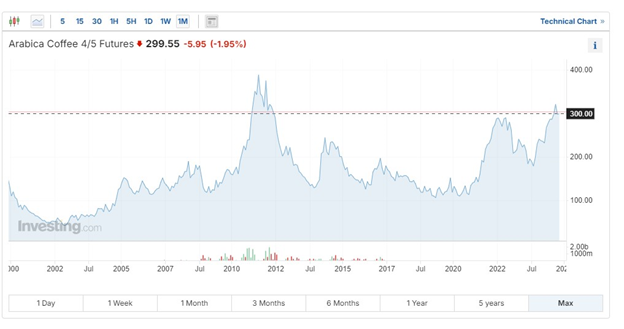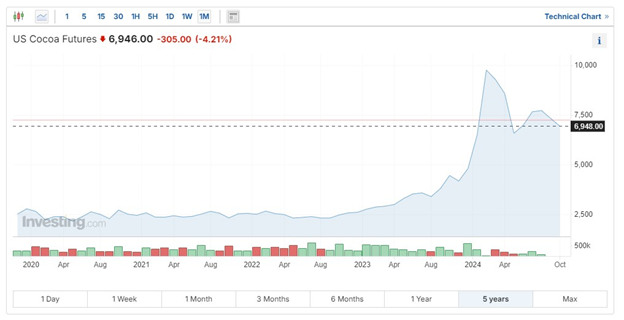Americans need their cup o' joe, and they may not be willing to give it up anytime soon. Believe it or not, Americans drink more coffee every day than any other beverage, including tap water. However, coffee prices have been soaring — and they show no signs of slowing down anytime soon.
Import prices for coffee rose a little over 65% in less than two years, surpassing the record price index level from 2011. Meanwhile, the Producer Price Index for coffee, which measures the average change over time in the selling prices received by domestic producers for their coffee, has soared to heights never seen before.
It's a similar story with cocoa. The global price for cocoa spiked in April at an astonishing $9,865 per metric ton before falling to $6,421 in September — with this year's prices still much higher than those previously measured by the Federal Reserve Bank of St. Louis.
Unfortunately, those soaring prices don't just threaten the average coffee drinker’s and chocolate lover's wallet. They’re also threatening the stability of the commodity markets.
Commodity prices on the rise
In the near term, coffee and cocoa futures are soaring, creating potential opportunities for investors.
Those happy to take on the high risk of what could happen if or when coffee or cocoa prices get so high that consumers can no longer afford their favorite beverage or treat, sending demand plummeting.
Unfortunately, though, the commodity markets are notoriously volatile.
On one hand, Arabica coffee futures reached a 13-year high on Sept. 26. Over the past 12 months, coffee futures are up more than 44%, while cocoa futures have gained 79%.
U.S. cocoa futures for December delivery surged in early 2024 before coming down but remain very high relative to recent periods.

On the other hand, what goes up often must come down, although the root cause of tumbling coffee and cocoa prices could become ultra-low production — paired with speculative fear.
How climate change is affecting commodity markets
Climate change is impacting agriculture around the globe while the world's exploding population growth also contributes to surging demand.
For example, production in Brazil, known as the "coffee pot of the world" because it produces more than one-third of the world's coffee, has been facing serious weather problems in recent years. This year, the worst drought in over 70 years has weighed on coffee production in Brazil, threatening to send prices even higher.
At this point, coffee prices haven't yet reached the record high seen in the late 1970s, when a major frost destroyed 70% of Brazil's coffee plants. However, they are at a 13-year high after adjusting for inflation, according to the International Coffee Organization. Farmers have also said their 2025 crop has already been affected.
Other climate-related threats are projected to raise temperatures in key coffee-growing regions higher than those required for optimal growth by 2050. Further, it's estimated that the amount of land available for growing coffee will be reduced by 55% to 62% by 2050.
Due to all these factors, global coffee production is projected to be slashed in half over the next 30 years — despite the growing demand for America's favorite beverage.
A similar story in cocoa caused JPMorgan to question whether it could trigger a "chocolate crisis." Climate-related disasters have weighed on cocoa production in Ghana, the world's second-largest cocoa producer, and the Ivory Coast for the last three growing seasons. More recently, cocoa futures skyrocketed 80% year to date as heavy rains disrupted the harvest in the Ivory Coast.
Agtech solutions to stabilize the commodity markets?
What if coffee and cocoa could be produced with significantly less water and less land, making prices for this commodity more stable? Some new technologies are making this possible.
For example, 3D cell-expansion technologies using coffee plant leaves are estimated to produce the same amount of coffee as that produced by 1,000 plants in only three weeks. Using 3D bioreactors, companies can mimic the conditions in which coffee is grown naturally to produce ground coffee — without having to grow whole coffee plants and within a couple of weeks.
This form of plant cell cultivation provides cells with the natural ideal growing conditions to produce targeted compounds while simultaneously minimizing the environmental impact of coffee production, as current production methods have a high carbon footprint and contribute to deforestation, increased water usage, and extensive pesticide use.
Plant cell cultivation also allows “lab-based farmers” to have complete control over all parameters that an agricultural product needs throughout the growth cycle in a unified manner and in a closed, automated system.
Other solutions to producing beanless coffee include upcycling ingredients like date pits, which are then blended with grapes, chicory root and tea-derived caffeine to create a coffee-like drink.
According to the startup developing this process, it uses 94% less water while emitting 93% less carbon than conventional cold brew.
Similarly, producing cell-based cocoa products has been compared to cultivating meat, only simpler. The game-changing technology is believed to produce a stable supply of cacao, which is unprocessed cocoa, year-round — no matter what weather conditions look like. Producing cultivated cocoa also involves the use of bioreactors to grow real cells before harvesting them, preparing them and packaging them into final products.
Agtech solutions for other food staples
In addition to common commodities like coffee and cocoa, other food staples, including vegetables, grains, meat, and fish, are also being threatened. Another example is the global vanilla market was estimated to be worth $3.2 billion in 2023 with a compound annual growth rate of 5.7% through 2032, making it worth $5.3 billion by then.
Like coffee and cocoa, natural vanilla faces a potential shortage in the near term due to bad weather in and around Madagascar, which produces 80% of the world’s supply of this food staple.
However, agtech is coming up with solutions for the potential vanilla shortage too. Spero Renewables has been working on producing natural vanilla from the far more widely available corn fiber. The company’s process involves extracting ferulic acid from corn fiber and then fermenting it to make natural vanilla.
Dr. Ian Klein, chief technology officer of Spero Renewables, explained in 2020 that they’re using the same process that vanilla is made from within the vanilla bean. However, they’re able to do it outside the vanilla bean, slashing the cost of vanilla production and solving the other climate-related issues.
Seeking long-term stability over volatility in the commodity markets
The consumer market for cocoa is already displaying early signs of what could eventually destabilize the commodity side of the market. According to JPMorgan (NYSE:JPM), consumers have already been responding to soaring chocolate prices as the confection loses share to other products. If cocoa prices remain high, demand could plummet, sending the commodity market into a tailspin.
Of course, speculation has also been a key piece of the stability puzzle in the commodity markets, often triggering volatility within. For example, the cocoa market has been extremely volatile this year due to supply-side fears. More broadly, the global food markets destabilized in 2023, when Russia suspended a deal that allowed Ukraine to export grain.
While no one technology will provide solutions to these food-related issues overnight, the good news is that fixes are in the works. If or when the supply of commodities such as coffee and cocoa is stabilized, fear and speculation in the commodity markets stand to decrease, also cutting volatility for investors and cost concerns for consumers.
